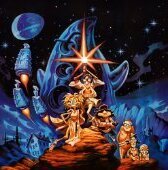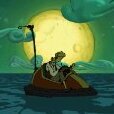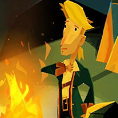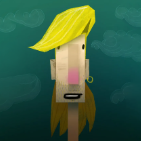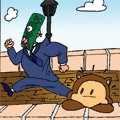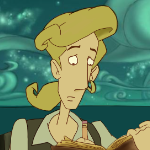Leaderboard
Popular Content
Showing content with the highest reputation on 09/30/22 in all areas
-
As I kept reflecting on the ending, some new thoughts have sprung. This will be an enormous post, soI’ll be truly grateful to those who manage to read the whole thing. So called “metanarratives” have been told before, across various mediums, whereas by placing the audience as the unwilling target of some sort of storytelling, fourth-wall breaking pun, or resorting to the “it was all in the main character’s head and imagination all along” angle. Regardless of how masterfully conceived these “metanarratives” can be (whether in the form of books, movies, etc.), there is inevitably a gap, a distance, between what the characters are experiencing and what is our own reaction to those experiences. A good storyteller will diminish that distance, create greater empathy between the audience and the characters, but we are still outside witnesses, external observants. We can be touched emotionally by the story, but that tends to come down to how much empathy has been conjured between us and the characters, on how much we can imagine ourselves in the characters’ shoes, on how much we can “relate”. However, I feel RTMI takes this to a whole new level, using a storytelling method that is a particularly perfect vehicle for exploration of this kind of thematic undercurrent: the point and click adventure game. This goes beyond the mere notion of being able to control where the main character goes, or how long we can linger in certain places or even the choices of dialogue (within the obvious limitations of the game framework). Those are just the mechanical and functional means of the storytelling experience. We learn, in what I think is a pretty definitive and unequivocal conclusion, that the world of Monkey Island is a plateau of existence, a mental place, a dimension, if you will, where Guybrush finds solace, refuge, escapism and entertainment. I won’t go into the discussion whether this dimension is any more real than the one where his everyday existence is taking place. What seems pretty definitive to me, is that those two dimensions are separate, they are two different things, although elements from the “everyday dimension”, to a certain extent, seem to feed the fabric of the Monkey Island dimension (and probably vice-versa. as well), as the things we experience almost subconsciously in our everyday lives can also feed our dreams. This Monkey Island dimension might have been triggered by Guybrush’s experiences, both as a child and as an adult, in a pirate themed amusement park, as a way to escape from a reality that is either too sad, too painful, too dull or too empty to face without solace. The details really don’t matter. And this is where the “metanarrative” comes to its full fruition. We are not witnessing Guybrush escaping into an imaginary pirate world, as he tries to take some reprieve from his everyday existente, while feeling empathy for his plight. No, we are Guybrush! As much as I ever felt in any work of art, we are indeed the character. We are not empathizing with Guybrush, we are not relating to Guybrush. We truly are Guybrush. We are the ones looking for solace, refuge, escapism and entertainment in a fictional pirate world. We are the ones (particularly in this forum of such dedicated fans), who treasure and look forward to the moments we spend in this Monkey Island dimension. We don’t do it to spend the time while waiting for the train to arrive. We don’t do it because there’s nothing else to do. We don’t do it to fill in the blanks in our daily schedule. We make it a pinnacle of our leisure time. It’s primetime worthy. In those playing hours, we rather be in the Monkey Island world than in whatever real life has to offer , regardless of how happy or fulfilled we feel. I don’t play Monkey Island the same way I play other games. Not even in the same way I play other point and click adventure games. It’s not to reach the end, get a dopamine fix or an adrenaline rush. I play it for the experience, to live in that world for a bit. That’s why I like linger in the wonderfully evocative locations, just wander around the locals, why I look forward wish to get stuck certain puzzles, so as the music and ambiance seep through my skin and become engrained, so as to when we listen to the soundtrack, it will immediately conjure up memories and feelings of those precious moments spent in the Monkey Island dimension. And I know Monkey Island is not real. Guybrush knows Monkey Island is not real. But it is true. And it matters. And that’s why we like to discuss the minutiae of this world, what things are “more real” than others (although nothing of it is really real), why we hang posters of it on the wall, listen to the soundtracks, replay the games knowing by heart all the solutions to every single puzzle. We want to keep visiting the same amusement park, we get excited when there’s a new ride on the horizon and we love riding the same old, well-worn, familiar rides.. And when not in the amusement park itself, we reminisce by looking at ticket stubs, park maps, promotional brochures. And I, like Guybrush, want Monkey Island to be as real as possible. So I keep chasing the horizon, clinging on to every small thing that might make it a little bit more concrete. I want to make LEGO models of Melee Town, the Giant Monkey Head and Woodtick. I want character statutes to proudly display on my bookcases. I want to wear T-Shirts of the Legendary Treasure of Melee Island. But it is not real. It 's not concrete. It can’t be. And just like Guybrush, I felt disheartened when I reached the back alley of Melee Island at the end of the game. It’s time to go home. My day at the amusement park is almost over. No more new rides to try. It’s with heavy hearts that I turn off all the lights in the park. I have to get back to my more mundane existence. But this game gives us something absolutely new. Almost revolutionary. It shows us a Guybrush with a life outside of Monkey Island. And a happy and fulfilling life at that, with a beautiful family. And we realize, maybe for the first time, that Guybrush doesn’t really need Monkey Island anymore. He’s ceased to be obsessed by it. And this is where The Secret comes in. And how it really could never have been something of true importance. It was a red herring all along, a distraction, something with an importance that grew in an unwarrantedly disproportionate manner throughout the years. It was ever only something that was part of the fabric of Monkey Island, among many other things. It was never its raison d'être, never a cipher to understand the whole thing. Monkey Island is not a mystery to solve, but a “reality” to experience. Like life itself. Lechuck lost sight of this. Monkey Island ceased to be a “good place”, where one could have sprawling adventures, meet colorful characters and visit fascinating places. It was all about The Secret, looking for some sort of resolution, an answer, something with which to cover the gaping holes in his existence. At the end of the game, Guybrush is finally freed from this anchor (ohh, symbolism). He can now visit Monkey Island because he wants to, not because he has to. It’s something that adds to his life, it doesn’t replace it. And it has become a pure thing again. A place where he can play pirates, simple as that, only constrained by the limits of his imagination. Stories being told around a campfire. In light of this, the very beginning of The Secret of Monkey Island has become even more perfect. Guybrush arrives at Melee Island not by ship, but by walking through a stone archway, as it were some sort of portal, and declare bluntly and plainly: This is all we want. We are Guybrush from the very start. We want to be pirates in a make-believe world. That’s why we are playing. Even the setting is perfect. How else would a Pirate setting be enticing unless when seen and interpreted by a child-like imagination? Throw any serious degree of historicity in it and the whole thing crumbles, with all the pillaging, violence, depravity and filth involved. It has to be a Pirate universe as imagined by a child. Again, it was never about The Secret. The whole point of experiencing Monkey Island is perfectly captured by the very first thing Guybrush says. There can never be a Monkey Island prequel. There’s no other possible beginning. To do it would be to corrupt it. Nothing exists before that declaration of intent. That’s where the whole dimension of Monkey Island is born. “I want to be a pirate”. That’s the absolute summation of what Monkey Island is all about. At the end, Guybrush (and myself), realize there’s peace to be found in knowing there’s no deeper meaning behind all of it. Monkey Island is a “good place” to visit every now and then. Guybrush has regained the purity of intent shown in that very first scene in The Secret of Monkey Island. The whole thing has become unburdened by overarching narratives, unsaddled by strict continuity between adventures, freed at last from the shackles of having to provide answers and meaning. Elaine emphasizes this by suggesting yet another adventure. Of the simpler, purer kind. And how perfect and crucial that little intervention is. Brings the whole thing full circle. And Guybrush sits on that bench, looking truly at peace with himself (as I see it), having regained the true purpose of Monkey Island. That image is the perfect coda to the Ron Gilbert trilogy. The lookout scene in SOMI as an overture. This is one as an epilogue. The world of Monkey Island is now wide open. There was never a better time to create new stories in it. Purer stories. With more cannons and less “canon”. I became a father 6 months ago. A little Boybrush named Manuel. Like Guybrush, I now have a family to share the world of Monkey Island with. And it has become something new again.12 points
-
This is from the pre-release thread but it’s still compelling I think, especially given Ron’s cryptic post on Twitter a while back asking why Guybrush arrives on Melee Island via the arch and not via the docks — something he does again in Return. * Archway? Park entrance? * Guybrush and blind Melee lookout stand in the same place as Guybrush and deaf Booty lookout relative to the entrance? * Big Whoop is Booty Town but also not? And in Return now a seaside park too? * Big Whoop ticket desk is Captain Dread’s ship? * Guybrush arrives on Melee expecting weenies, which happen to be next to the Big Whoop entrance? * You also start Monkey Island 2 next to a weenie shop?????6 points
-
I love the museum guys explanation that they could fix the clock, but at this point it would confuse the citizens. 😄 I love these “holes”, to me they make the world feel bigger, and reinforces Guybrushs “tunnel vision”. There are even more of them. There seems to be a whole story about Lockes mom that we only scratch the surface of. Widey is always living close to Locke? What is that all about? My gut feeling also thinks that Lockes mother created the safe, not Stan. I have zero proof. Just a feeling. And I am satisfied by not knowing the answer, but just know that are more actors and stories out there that we dont fully hear until Guybrush wants to actually listen to them instead of just focus on keys and The Secret. I love it!3 points
-
Nah, I don't think so. I read it as just a continuation of Guybrush not getting any recognition for his dubious exploits. (eg. "I heard LeChuck drank so much root beer he exploded.")2 points
-
I had to squeeze this wonderful promotional artwork for "Dark Forces" in. Painted by David Grove, this was used for print ads in several magazines back in the time. Interestingly, the original painting was created with much brighter colors, and later darkened for printing. Surely this was intentional, as the art works much better this way, given the game it was created for. I've created several different versions for this:2 points
-
2 points
-
2 points
-
Yes, because it is up to the owner/manager of the pirate-themed escape room (Stan) to prepare the rooms with puzzles, and the preparation includes locking objects in places that must be opened with keys. The escape room is not just a park to be passively observed, but an interactive experience that poses challenges that Stan constantly improves. That's why Guybrush says: ... which also explains why the Voodoo Lady says that she has signed a contract and can't help you to open the safe. She is part of the escape room staff. And everything fits quite nicely if you take in account something that Ron Gilbert said in 2017 in a Reddit AMA: (Source)2 points
-
Ok, I guess I should do a new ranking. Not gonna put all the other Lucasarts titles in this time though. 1. Curse 2. LeChuck's Revenge 3. Return 4. Secret 5. Tales 6. Escape If you've seen my posts about the ending to Return, you may be under the impression that I don't like the game. Nope, I'm just having a bit of trouble digesting the final moments and what it all means for me, but it's overall really good. Just not top 2 good...but maybe that'll change over time.2 points
-
I don't know if this was already discussed, but why did the melee clock show a different time on the map to the secret? I thought that there was gonna be a puzzle where you had to repair the clock and change the time according to the map (8 o'clock or maybe 11:40? hard to tell) to get access to the secret. But no. Also: who put the safe there? Stan?2 points
-
Yes, precisely. I do sympathise with my unrealistic expectations (it would be weird if Ron and Dave remembered every detail after all these years, would they have been replaying their own game for 32 years?? -- eek). On the flip side, who else was ReMI for if not the people who have been wondering about the end of MI2 for decades? So it's a balance... When films do this sort of thing, they tend it get it more right... but that's probably because it's much easier to watch and movie and see everything. In games there's a bazillion little branches and obscurities. (Of course, they also often hire fan-experts who point out any contradictions.) I do have to say that the ending of ReMI has possibly made me less enamoured with the series... or I guess I mean it's made me want to move on from it. As I said in another post, I'm starting to feel like a middle-aged man dressed in faux pirate attire sitting on a park bench. My two favourite things in the world (Twin Peaks and Monkey Island) got decades later follow-ups and conclusions. I think I'm a bit done with looking backwards. Maybe it's time to focus on finding new things to fall in love with...2 points
-
Just discovered that when you ask Wally about the signs in Mêlée Town, he says that he designed them on Madison's behalf. This is another one of those nice details that brings the world to life, as you realize that the characters are also acting independently of you. This was done very well in MI1 and 2 too, especially on Mêlée Island (The store owner, Carla and Captain Smirk all know each other, everyone already has a rubber chicken from the Voodoo Lady etc.). EDIT: When you win the three contests, the queen's ice sculpture on Brrr Muda turns into one of Guybrush's (if you haven't melted it before by lighting the torch Next to it) and the pictures in the courtroom and the town hall are now pictures of him too. There are also one or two new dialogue lines when talking to the people there.1 point
-
Picking up from a bit earlier in the thread, I just don't think I can buy the idea that we start off with the kids imagining the end of Monkey Island 2, break out of that into something approximating the real world and then submerge again into a different pirate fantasy when we take control. I think they were imagining a fancy carnival and then we get to see the slightly gross park underneath, and I didn't once think to question that when I was playing. Another thing which I think makes it more likely is the way the SPIT FUN banner has RUN pasted over it. Why would Boybrush be imagining a race instead of a spitting contest if the idea is that he's now imagining the world as more gross and piratey? That said, I think the wishing well is there to show us that there is some room for the boundary between imaginitive play and reality here, and that not everything we see on screen at any one time is either necessarily all real or all imagined.1 point
-
1 point
-
1 point
-
I second that! It’s really worth every piece o’ eight!1 point
-
Might be better to put this in the spoiler forum since every answer will directly relate to the ending of Return, no? 🤔1 point
-
I have I have a someone unique perspective on this having seen it from both sides in real life, but The Simpsons parodied this relationship perfectly...1 point
-
When I first heard about literal "escape rooms", it definitely felt like they had inspiration from adventure games. They even use some of the same moon logic.1 point
-
I like to think of the "for whom" theme as "the game was dedicated to us" but not more than that. Unfortunately, I've seen the "for whom" theme exploited by some fans in other social venues to imply the existence of some sort of "moral debt" that developers should feel obligated to repay. That's where I disagree. I find this interesting because I feel the same way, but probably for different reasons than you do. I just got that closure from RtMI that I was looking for, so I no longer feel the need for a new chapter in the story. What I always envisioned as a trilogy has finally been completed. Of course, if more games come along I will still play them, just as I played the games in the franchise that didn't interest me much, but I already feel satisfied with the circle that has been closed for me. That's why moving on and preserving the experience in my heart might be the most natural thing for me to do. 🙂 Yes, that's something that should always be kept in mind. Creators and fans live a game in very different ways. There is a funny scene in Galaxy Quest in which the relationship between actors and fans pointing out obscure mismatching details is parodied with excruciating accuracy. 😁1 point
-
🚨🚨🚨 Please wrap any Return to Monkey Island spoilers in spoiler tags. 🚨🚨🚨1 point
-
I do not remember escape rooms existing 30 years ago, at least not in their current form, but NightWalker pointed out something that might be similar. However, despite the references to previous games, the important point to me is that RtMI is definitely a game that has embraced the present, and in 2022 escape rooms exist and may have been an inspiration for the new game. I find this statement by Ron particularly enlightening, especially regarding the fact that being trapped in the past can limit creativity: (Source, translated from an interview in Italian) This is not the only statement regarding the fact that the developers did not want the game to be trapped in the past. In April 2022 they stated: (Source) I remember that this sentiment had also come up in other interviews, so I was well prepared for the fact that the authors did not want a game that tried to adhere to past ideas. In 1990 we did not have fully voiced characters or social movements critical of science-backed health care, but both are common now in 2022 and the game makes use of them. Escape rooms might have been another modern inspiration for the writing.1 point
-
One of the best analysis I have ever read about the series. I agree with every concept you expose. I think that is the true meaning of the ending too. You exposed it perfectly.1 point
-
👕 I beat #Mojole #192 and all I got was this stupid t-shirt. 4/6 🖤🖤💛🖤🖤 🖤🖤🖤🖤💛 🖤💚🖤🖤🖤 💚💚💚💚💚 https://funzone.mixnmojo.com/Mojole/1 point
-
Man, what a missed opportunity! It would have been so satisfying to finally fix that clock after all this time, especially after Guybrush makes that comment about it being broken. Maybe those dark runes graffiti could have also come into play since it's in the same area. I keep meaning to ask about that. Who told Corina to store the safe there and not allow anyone to move it? It has to be Stan, since it contains the gaudy chest we see at the end. But I was really hoping for more exposition to come out of this revelation, and why it becomes so convoluted with the five keys and everything. Also, Widey Bones: Feels like there is so much we have yet to learn about her, but then she turns out to be another cardboard cut-out. Dang, the more I think about it, the more I can pick apart holes.1 point
-
Nice observation on the clock, never noticed that. As for the safe, my take was it was indeed Stan who left the safe there given that Guybrush (and the hover-over text) reveals at the end that Stan was behind the gaudy chest.1 point
-
Oh boy, I got a few bad takes. 1. I actually love EMI and I think the 3D art is perfect as an adaptation of CMI's art style. Monkey Kombat just felt like the games insult sword fighting and I don't mind it. 2. I could never really get into LOOM. I've tried multiple times but just never get invested. Especially weird because I make music, so you'd think I'd love the music system. 3. I think the world of Monkey Island shouldn't be real. Love me some goofy pirate fun but I think having that somewhat sinister and emotional layer on top makes the world far more interesting. 4. Tales might be my least favorite in the series. I think episodes 4 and 5 are absolutely fantastic but the first few feel like a slog. Also, I REALLY don't like the art style. I understand that TT had a deadline and a budget but I find the character designs to just be really unappealing and I think EMI did a better job of translating the CMI style to 3D.1 point
-
A formative event in my young adulthood was watching the DVD commentaries for Monty Python and the Holy Grail. Cleese, Idle, Gilliam, Jones, and Palin were spread across two different commentaries, you see. At one point, a couple of them are laughing and remembering as a new scene comes up. They start quoting the scene. And they quote the scene wrong. They quote the scene wrong, a bunch. A little part of my fanbrain is still working it all out. But it was formative for me in realizing: these creators have given us tremendous gifts and shown immense brilliance in creating them. In many cases, it has been a labor of love and a bit of their lives. However, it has not been the entirety of their lives. Because they are healthy humans, it was not even the focal point of their lives. It was a job... maybe a job they enjoyed, and maybe one that they still remember fondly. But it was a career and a creation - it was not a hobby. If you played Sonic the Hedgehog, then Sonic Mania is safe. Shovel Knight is also good for a hodgepodge of NES feels, but reddit tells me the jury's still out on its latest sequel.1 point
-
1 point
-
I agree, but I would also add that even when Guybrush opens up the chest, he takes the Secret and disappointment in stride. He still moves on from it for better things. LeChuck's crew all bailed on him because they were horrified what would happen because he does not handle frustration or disappointment well. That is perhaps a key difference between Guybrush and LeChuck. Guybrush can move on while LeChuck is defined by it. The idea of him keeping the key because he never have up on it is a fascinating one, but he seems to have set it aside to start a family, at least for now. I really like this take as well.1 point
-
Game info: the Big Whoop map pieces - Upper left is Lindy's piece (with a compass rose), which Guybrush bought at the Booty Boutique - Upper right is Rapp's piece (with the X on it), which Guybrush received from Rapp - Lower left is Rogers' piece (with the landing site and Rogers' arm still attached), which Guybrush found below his cabin - Lower right is Marley's piece, which Guybrush found in Elaine's possession All four pieces were last possessed by LeChuck's forces after they were seized from Wally. - The piece in Guybrush's scrapbook is Lindy's piece, its compass rose still visible. - The piece in the museum is Rapp's piece, the curator having acquired it from Wally, but the zoomed-out nature makes it unclear whether the big X is still visible. HEADCANON 1: Wally reacquired Rapp's map piece because it landed near him when the Fortress exploded. HEADCANON 2: The big X on Rapp's piece has faded away with time. It wouldn't be visible on a zoom-in. HEADCANON 3: Guybrush saw Lindy's piece in a store recently at a very low price because it was old/obsolete, and he happily rebought it. This final headcanon mirrors the handful of instances when, in adulthood, I've rebought old games or game rereleases that I had in childhood but had lost or garage-sold. I like to think that Guybrush literally purchased this map piece on two occasions, decades apart.1 point
-
I didn’t really consider this before, but your comment about Guybrush’s brother made me remember that that whole brother exchange did happen in MI2, even though in ReMI it’s just Guybrush’s friend, right? I think my head is roughly at: * During MI2 we see Guybrush as a child playing around with his brother * During ReMI we see Guybrush’s son playing around with his friend, reenacting one of his dad’s made-up stories * During ReMI we also see Guybrush making up a new story for his son I am leaning towards all of it being made up, however grounded in the fabric of places where Guybrush and his family spend time at different points in their lives. An amusement park, a seaside park, a theme park — we see all three and they’re quite distinctive from one another. 😄1 point
-
We've been updating TP Explorer to add support for ReMI but its still a work in progress. Proper music dumping will come in the next release, I have it working manually but I done the code to do it automatically yet.1 point




